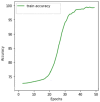Classification of Diabetic Retinopathy Disease Levels by Extracting Spectral Features Using Wavelet CNN
- PMID: 38893619
- PMCID: PMC11172049
- DOI: 10.3390/diagnostics14111093
Classification of Diabetic Retinopathy Disease Levels by Extracting Spectral Features Using Wavelet CNN
Abstract
Diabetic retinopathy (DR) arises from blood vessel damage and is a leading cause of blindness on a global scale. Clinical professionals rely on examining fundus images to diagnose the disease, but this process is frequently prone to errors and is tedious. The usage of computer-assisted techniques offers assistance to clinicians in detecting the severity levels of the disease. Experiments involving automated diagnosis employing convolutional neural networks (CNNs) have produced impressive outcomes in medical imaging. At the same time, retinal image grading for detecting DR severity levels has predominantly focused on spatial features. More spectral features must be explored for a more efficient performance of this task. Analysing spectral features plays a vital role in various tasks, including identifying specific objects or materials, anomaly detection, and differentiation between different classes or categories within an image. In this context, a model incorporating Wavelet CNN and Support Vector Machine has been introduced and assessed to classify clinically significant grades of DR from retinal fundus images. The experiments were conducted on the EyePACS dataset and the performance of the proposed model was evaluated on the following metrics: precision, recall, F1-score, accuracy, and AUC score. The results obtained demonstrate better performance compared to other state-of-the-art techniques.
Keywords: Wavelet CNN; classification; computer-aided diagnosis; convolutional neural network; diabetic retinopathy; spectral features.
Conflict of interest statement
The authors declare no conflict of interest.
Figures








Similar articles
-
Diabetic retinopathy classification based on multipath CNN and machine learning classifiers.Phys Eng Sci Med. 2021 Sep;44(3):639-653. doi: 10.1007/s13246-021-01012-3. Epub 2021 May 25. Phys Eng Sci Med. 2021. PMID: 34033015
-
Multi-scale multi-attention network for diabetic retinopathy grading.Phys Med Biol. 2023 Dec 22;69(1). doi: 10.1088/1361-6560/ad111d. Phys Med Biol. 2023. PMID: 38035368
-
Artificial intelligence based glaucoma and diabetic retinopathy detection using MATLAB - retrained AlexNet convolutional neural network.F1000Res. 2024 Apr 3;12:14. doi: 10.12688/f1000research.122288.2. eCollection 2023. F1000Res. 2024. PMID: 38826575 Free PMC article.
-
Advancing Diabetic Retinopathy Diagnosis: Leveraging Optical Coherence Tomography Imaging with Convolutional Neural Networks.Rom J Ophthalmol. 2023 Oct-Dec;67(4):398-402. doi: 10.22336/rjo.2023.63. Rom J Ophthalmol. 2023. PMID: 38239418 Free PMC article. Review.
-
Retinal Disease Detection Using Deep Learning Techniques: A Comprehensive Review.J Imaging. 2023 Apr 18;9(4):84. doi: 10.3390/jimaging9040084. J Imaging. 2023. PMID: 37103235 Free PMC article. Review.
References
-
- Yahaya S.W., Lotfi A., Mahmud M. Towards a data-driven adaptive anomaly detection system for human activity. Pattern Recognit. Lett. 2021;145:200–207. doi: 10.1016/j.patrec.2021.02.006. - DOI
-
- Fabietti M.I., Mahmud M., Lotfi A., Leparulo A., Fontana R., Vassanelli S., Fassolato C. Detection of Healthy and Unhealthy Brain States from Local Field Potentials Using Machine Learning; Proceedings of the International Conference on Brain Informatics; Padua, Italy. 15–17 July 2022; pp. 27–39.
-
- Akter T., Ali M.H., Satu M.S., Khan M.I., Mahmud M. Towards autism subtype detection through identification of discriminatory factors using machine learning; Proceedings of the International Conference on Brain Informatics; Virtual. 17–19 September 2021; pp. 401–410.
LinkOut - more resources
Full Text Sources

